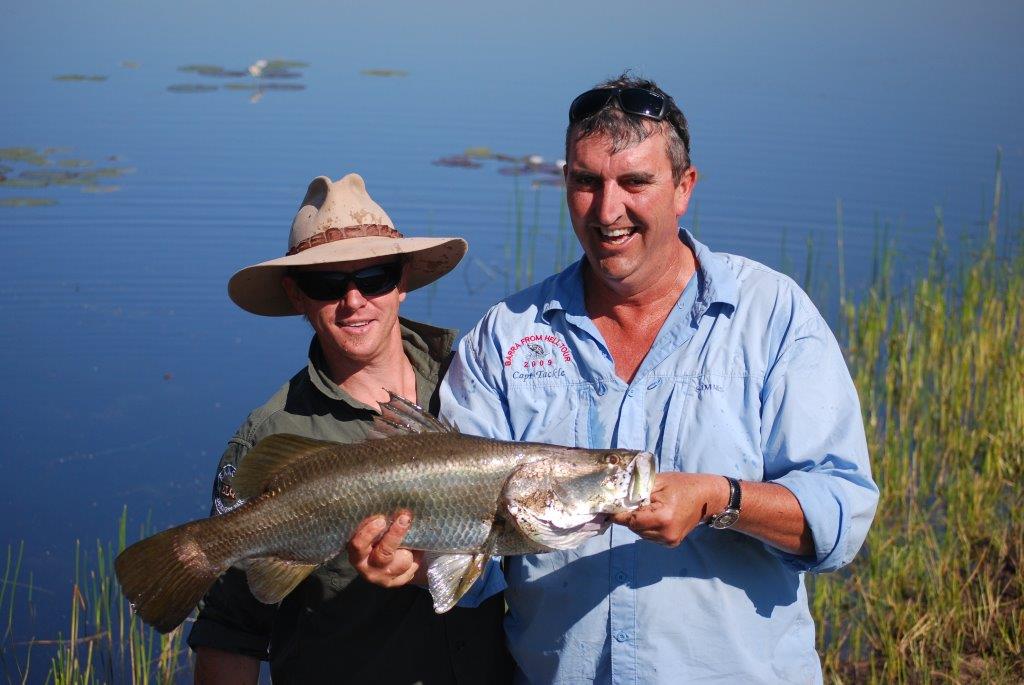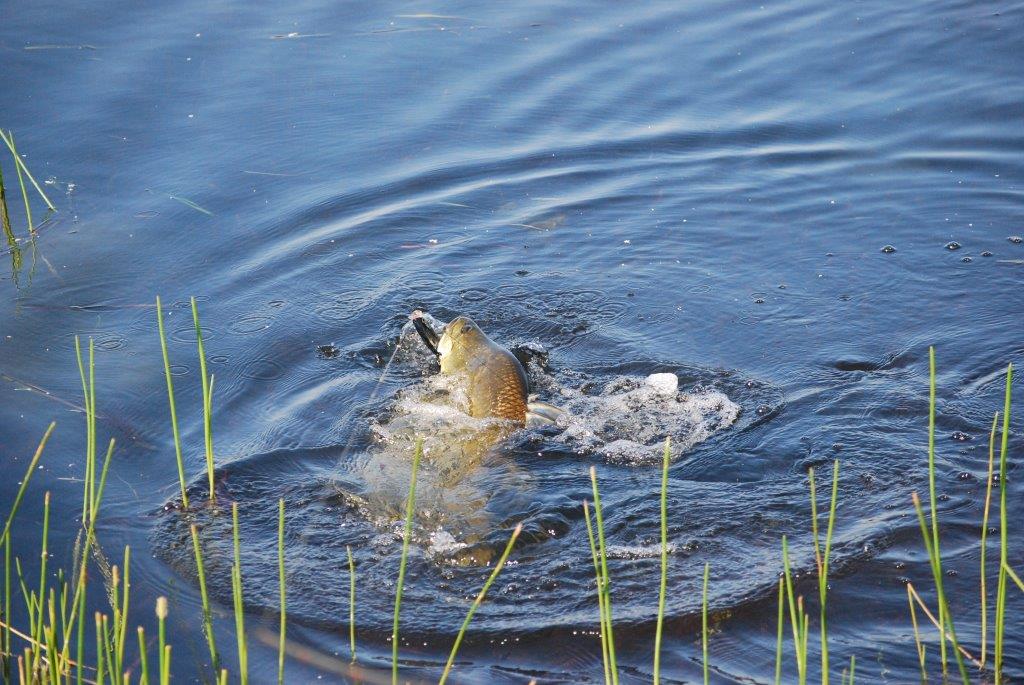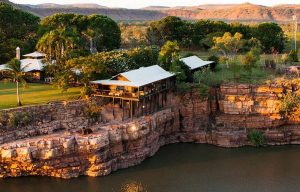Go Popper by Chopper
Heli-Fishing at El Questro
A three day stay at El Questro’s world renowned homestead was a fantastic way to regain our “land legs” having just spent a week cruising the North Kimberley Coast aboard the luxurious “True North”.
The El Questro Wilderness Park is a million acre property which gained its notoriety when a young English gent and his wife, Will and Celia Burrell purchased the pastoral lease in 1991 for a dollar an acre. They were absolutely captivated by its vast beauty which provided spectacular landscapes and the incredible flora and fauna held in its inaccessible terrain.
Will is a visionary whose dream turned to reality. Without impact on this magnificent frontier, accommodation was developed ranging from secluded river side camp sites to the exclusive six suite homestead.

El Questro is open to the public between April and October each year after the wet season has replenished the rivers and gorges. Like all top end destinations, the build up and run off before and after the wet are the prime times to focus on our favourite sport fish, the barramundi.
August would be viewed as one of the tougher months to be able to target old “bucket mouth” in the easier to access waterways around El Questro. Whilst they’re there, and I had numerous sight casting opportunities from the electric powered tinnie which is available to guests, getting a response was near impossible. Mind you, the tinnie wasn’t required to spot fish as I probably saw more when enjoying a cold beer on the deck of our room, or whilst dinning with the better half on the edge of Chamberlain Gorge.
The only joy close to home were a few feisty sooty grunter, which whilst fun on a 2kg spin outfit using tiny poppers, weren’t going qualify as a strong finish to an epic trip. The fishing on True North had provided some great light tackle bluewater and Barra sessions and I was hell bent on one last barra hitout before heading home.
Now you can’t be deterred if the best option isn’t at your doorstep, the great thing about places like El Questro is their shear size and the frequent use of helicopters as a form of transport.
A sun rise departure with local chopper pilot Digby the next morning had us flying over some of the most amazing gorge country along side the Cockburn Ranges, with each water hole we passed being alive with an array of bird life including big numbers of brolgas and jabirus. Joining us was one of the park rangers who I’d met on the first day during the trip in from Kununurra. Brendan was also a pretty keen fisherman and didn’t get too many opportunities to jump on the chopper for the sole purpose of chasing a few barra, and was as excited as I was.
I’d be lying if I told you I knew where we were when Digby set us down other than to say it was about twenty minutes flying time since we’d spotted a man made structure and we travelled west. Why he picked this particular billabong ahead of so many others that looked the same seemed like pot luck at first, but Digby’s knowledge of the local crocs through frequent sightings and more importantly where they weren’t, meant this was a pretty safe option. Got to be happy with that.



Surface lures were the go and pretty much the only option due to the extensive weed growth which had occurred during the colder months, as it tried to get as much exposure to the sun as possible.
Blooping poppers and walking stick baits is about as much fun as you can have on the visual side of a barra strike, although doesn’t provide the same hook up rate. This theory proved correct as the Tango Dancer I was using bobbed from side to side it was boofed two or three times on each of the first few retrieves without success.
Brendan was the first to hook up working a small gold Halco Rooster Popper past some lily pads under which a nice fish of around 65cms was holding. An absolute explosion of water indicated the strike which was quickly followed by a couple of head shaking jumps and some dexterous rod work by Brendan. It was a great first fish for the morning which had that golden glow of a barra that’s been in the fresh for a while, illuminated even more by the early morning sun.
The conditions were like glass, accentuating the response of our lures to each twitch of the rod tip. Either the barra were toying with Tango Dancer or I’d left my mojo back at the homestead, but the other two guys had a couple of fish each bank side before I’d even looked like setting a hook.
Actual fishing time in a morning heli-fishing like this is around three and a bit hours after you allow for time in the air. We were about forty five minutes into it before I joined the others opting for a skitter pop rather than walking the dancer. Not exactly a lightning fast decision considering time was precious.
We worked our way along the bank a few hundred metres in both directions from where we’d landed, casting at the small clusters of lily pads and the grass covered shore line. There’s no doubt the extra water displacement of the popper made a huge difference in the attitude of the fish. My first hook up was only a small fish but hit with real enthusiasm heading straight into the weeds and then getting airborne adorned in a mass of green ribbon. OK, it was the smallest fish landed in the first hour, but I was on the board.
Whilst I’m a fan of the rooster popper, I think of it as a better bluewater lure than my first choice for a glassed off billabong. The good news from my point of view was that whilst I hadn’t troubled the scorers early on, the skitter pop was in a league of its own and was getting the majority of interest and action.
Under the glassy conditions was crystal clear water providing all of us with a few sight casting opportunities. As in most still water situations, success depended on working the lure into the path of the fish rather than any heavy handed tactics. It’s pretty cool watching a barra light up in these situations culminating in an awesome surface strike.
Whilst there wasn’t a lot of structure for us to aim at, the weed growth provided plenty for the barra to take advantage of and keeping the rod tip high was the position taken during most encounters. The great thing about this technique is the amount of aerial action it entices which combined with the surface strikes and water clarity meant everything was in full view from start to finish.
With about an hour to go, a moderate breeze kicked in disturbing the near perfect conditions we’d been enjoying, and with that the bite shut down.
In a bit over two hours we’d landed fourteen fish between 50cm – 70cm, dropped around another ten and couldn’t count the number of boofs trying to inhale our lures without success. Whilst not big fish, each barra provided a reasonable challenge and the visual nature of everything we did made this one special short sharp hit out.
The reality that the breeze had pretty much ended the chance of enticing any further action meant we set off a bit earlier than planned to take in a few extra sights on the trip home.


The vastness of El Questro is best explained by the fact that a couple of weeks after we’d left, a new set of waterfalls and rock pools were discovered by the Wilderness Park Manager during a routine aerial burn programme. Named Amaroo Falls, they comprise five waterfalls of up to fifteen metres with pristine swimming holes interspersed between them. How does something so enormous and spectacular only get discovered in 2010 when El Questro’s original pastoral claim was lodged in 1958 and the property has been operating as a tourist destination since the early 1990’s? It’s got to be a big inaccessible place to hide something like that for so long.



The whole experience of El Questro, no matter what part of the place you’re residing in is an amazing one. Four wheel driving to the lookouts situated 800m high and taking in the grandeur of the Cockburn Ranges and Kimberley Plateau; riding on horse back through broad valleys and between escarpments; bird watching of a calibre that draws people half way around the world; enjoy a therapeutic dip in Zebedee Springs set in its own micro tropical rainforest; bush tucker and educational tours where you’ll learn the secrets of thousand year old boab trees, the list goes on.
This is so much more than a fishing destination. Its genuinely one of the jewels of the Kimberley which is there for all of us to explore thanks to the vision of one couple who made their dream become a reality. Whilst no longer owned by the Burrell’s, I’m pleased to report many of staff whom Will employed during his time are still there, and carry the same passion for the place today as Will and Celia did when they first laid eyes on it. You have to add El Questro to your bucket list of must visit outback destinations if you haven’t already had the pleasure.
Graeme Russell